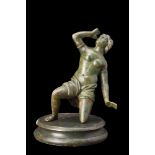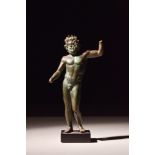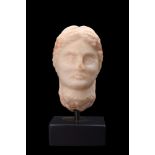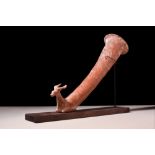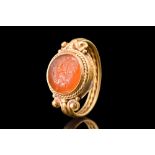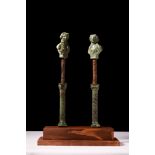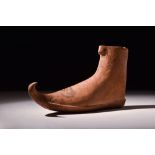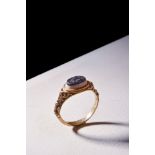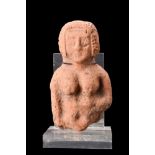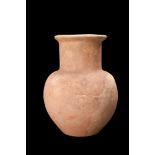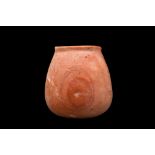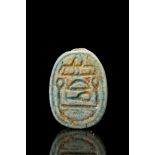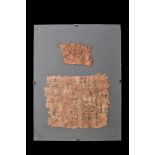Refine your search
Estimate
Category
- Coins (76)
- Jewellery (45)
- Arms, Armour & Militaria (44)
- Greek, Roman, Egyptian & Other Antiquities (43)
- Chinese Works of Art (32)
- Sculpture (32)
- Glassware (17)
- Islamic Works of Art (13)
- Ceramics (12)
- Salvage & Architectural Antiques (12)
- Collectables (11)
- Books & Periodicals (9)
- Classic Cars, Motorcycles & Automobilia (7)
- Metalware (6)
- Vintage Fashion (6)
- Furniture (4)
- Russian Works of Art (4)
- Stamps (4)
- Taxidermy & Natural History (4)
- Kitchenalia (2)
- Lighting (2)
- Oil, Acrylic paintings & Mixed Media (2)
- Scientific Instruments (2)
- Textiles (2)
- Tools (2)
- Carpets & Rugs (1)
- Indian Works of Art (1)
- Models, Toys, Dolls & Games (1)
- Porcelain (1)
- Silver & Silver-plated items (1)
- Watches & Watch accessories (1)
- List
- Grid
A subscription to the Price Guide is required to view results for auctions ten days or older. Click here for more information
Ca. 1st - 2nd century AD.A bronze figure of the goddess Iphigenia in active pose with right hand raised to the brow and left hand supporting her w...
Ca. 350-300 BC.A beautiful plate, fashioned from high-quality clay and adorned with a lustrous black glaze, showcases the red-figure technique wit...
Ca. 400 - 300 BC .A terracotta rhyton with a flaring lip, and a conical shaped body terminated into a equine finial; the trumpet-shaped both with ...
Ca. 100 AD. A bronze statuette of Jupiter depicting Zeus Brontaios, the Thunderer, modelled in the round after a statuette by Greek sculptor Leoch...
Ca. 4th century BC.A gold bracelet of a D-shaped form. Its meticulously designed openwork body unveils a visual symphony of intricate artistry. Th...
Ca. 300-100 BC.A matched pair of gold earrings, each formed of a wire tapering to one end and the other terminating with a biconical agate bead be...
Ca. 3rd-1st century BC. A large gold finger ring composed of a highly ornamented hoop with a small cabochon to the rear and a hinged mechanism at ...
ROMAN CARNELIAN INTAGLIO WITH A HAND HOLDING EARS OF GRAIN AND POPPY SEED HEADS IN A GOLD RING
Ca. 3rd-4th century AD. A carnelian intaglio presents a captivating scene in which a hand delicately holds ears of grain and poppy seed heads. Thi...
Ca. 500-300 BC. An impressive bronze helmet featuring a domed crown with a prominent front medial ridge. The helmet's design includes a contoured ...
Ca. 100-50 BC. A Buggenum type bronze helmet with a rounded bowl, folded brim, and projection on the top for attaching a plume. This was the most ...
ROMAN MARBLE HEAD
Ca. 100-200 AD.A marble head of a female, potentially representing a noblewoman, embodies the artistic finesse and cultural aspirations of ancient...
ROMAN GLASS AMPHORISKOS
Ca. 200-300 AD. A glass amphoriskos with a squat globular lower body, supported by a low circular foot and topped by a cylindrical neck with a fun...
Ca. 100-300 AD.Dark blue unguentarium with flaring rim, elongated neck and globular body. The deep blue colour of this glass is both beautiful and...
Ca. 4th-3rd century AD. A rare silver vessel boasts a broad and tall body that gracefully tapers down to a convex base, presenting an elegant and ...
Ca. 330-200 BC. The slender terracotta rhyton formed with a flaring lip and conical shaped body terminating into a stag protome with the head draw...
ROMAN BRONZE CERES STATUETTE
Ca. 100-300 AD. A very fine bronze statuette of Ceres (Greek Demeter), the goddess of agriculture and fertility, depicted standing and wearing a l...
Ca. 2nd-1st century BC. A carnelian intaglio showcasing a portrayal of the esteemed goddess Aphrodite. This intaglio reveals her in a state of und...
Ca. 3rd - 4th century AD. A remarkable intaglio featuring the captivating imagery of Mercury riding a rooster, nestled within a resplendent gold r...
Ca. 100-200 AD. An amethyst intaglio with a depiction of the revered deity Mercury, known as Hermes in Greek mythology. This intaglio portrays Mer...
Ca. 3rd-1st century BC. A gold ring set with jasper intaglio with an intricately engraved left-facing bust of a goddess. Her divine presence evoke...
Ca. 1st Millennium BC.A beautiful necklace of carnelian and agate graduated beads highlighted by 6 hollow coin-like beads and one large bead; all ...
Ca. 100-300 AD.A delicate pair of Roman gold earrings, each with a hoop with a small loop from which hang a gold drop, comprising inset circular r...
Ca. 100-300 AD. An outstanding pair of bronze and iron fittings, each one comprising a spiral fluted column with an iron rod projecting from the I...
ROMAN SILVER SKYPHOS
Ca. 100 AD.A silver skyphos, meticulously crafted, boasts an exquisite assemblage of features. Resting atop a circular concave low foot, this resp...
Ca. 100-300 AD. A glass phiale with its meticulously moulded, shallow form. The bowl showcases a rounded base that gracefully complements its over...
PHRYGIAN BOOT-FORM RHYTON
Western Anatolia, ca. 800-700 BC. A tan pottery low boot having pointed toe curved off to the side and an incise-stitched sole. Mid ankle length w...
ROMAN SILVER JUG HANDLE
Ca. 1-100 AD.A silver handle likely to have been part of a jug. At one end, a round finial featuring a face with flowing wavy coiffure adds a touc...
Ca. 100 BC - 300 AD.A beautiful necklace comprising biconical and barrel-shaped beads, interspersed with spool-shaped gold beads. For a comparison...
Ca. 400-300 BC.A beautiful earring composed of a hollow gold shank formed into a circular shape. The shank on the opposite ends is embellished wit...
Ca. 100-200 AD.A matched pair of gold earrings comprising a hoop with a hook and eye closure adorned with a highly ornamental boss shield with a r...
Ca. 400-200 BC.A gold finger ring composed of a round hoop with hunched shoulders and an integral bezel cell with garnet cabochon inset. Excellent...
Ca. 1-200 AD.A chalcedony intaglio displaying a bucolic scene capturing a man engaged in the act of milking a goat. Such a depiction, laden with s...
Ca. 200-300 AD.A carnelian intaglio with a depiction of Jupiter, the most powerful of the gods in Roman mythology. The god is portrayed in his lef...
Ca. 100-300 AD (stone); Ca. 200-400 AD (ring). A garnet intaglio engraved with a masterful depiction of the god Mars Gradivius, the Roman god of w...
Ca. 1-200 AD. A convex intaglio with a portrait of the legendary figure Hercules. This captivating depiction captures the essence of the hero thro...
Middle Kingdom, Ca. 1985-1773 BC.A rare Epsilon type bronze axe blade comprising of an elongated crescentric form with three rivet holes. For a di...
Ca. 1500-1200 BC.Sculpted from fine, thick-walled red terracotta, the relief showcases a slender nude woman with prominent, protruding breasts, he...
Late Period, ca. 664-332 BC.A mummy shroud composed of threaded faience beads arranged in a net pattern, which collectively form a remarkably deta...
EGYPTIAN FAIENCE USHABTI
Late Period, Ca. 664-332 BC.A captivating blue faience ushabti encapsulates the artistry and symbolism of ancient Egyptian funerary practices. Thi...
EGYPTIAN FAIENCE USHABTI
Late Period, 30th Dynasty, Ca. 332 BC.A light blue faience ushabti figure exudes an air of serenity and purpose. Adorned with a tripartite wig and...
Late to Ptolemaic Period, ca. 664-30 BC.An amulet, meticulously crafted from pale blue glazed composition, presents a captivating portrayal of mat...
Greco Roman Period, Ca. 30 BC - 200 AD.A faience New Year's flask of a lentoid body with twin arched handles flanking the trumpet-shaped spout. On...
Old Kingdom, ca. 2686 to 2181 BC.An offering bowl carved from alabaster. This vessel possesses a distinct aesthetic and functional design. With a ...
Ca. 3000-2000 BC.Carved from stone, the jar exhibits an inverted piriform body, evoking a graceful and harmonious silhouette. Its tubular, squat n...
Ca. 3000-2000 BC.A stone jar crafted from stone features a tapering profile that gracefully converges into its opening, providing both a pleasing ...
Ca. 1550-1070 BC.A light blue glazed faience beetle of naturalistic form with a notched wing case; the base has been inscribed, although now lost,...
EGYPTIAN ROCK CRYSTAL SCARAB
Ca. 1550-1070 BC.A nice example of a rock crystal scarab amulet in the form of a scarab with naturalistic detailing the clypeus, prothorax, and el...
Ca. 1070-1550 BC.A steatite Egyptian scarab with incised geometric pattern to the reverse. The moulded obverse features a detailed clypeus and hea...
Late Period, ca. 664-332 BC.A funerary shroud, meticulously composed of faience beads arranged in a distinctive net pattern. The shroud's captivat...
EGYPTIAN ALABASTER USHABTI
New Kingdom, ca. 1570-1070 BC.An alabaster ushabti. This mummiform figurine stands atop a diminutive, level base, with its hands gracefully crosse...
EGYPTIAN FAIENCE USHABTI
Late Period, Ca. 664-332 BC.A mummiform figure crafted from light-blue faience and adorned with a delicate glazed finish, this exquisite figurine ...
EGYPTIAN FAIENCE USHABTI
Late Period, 30th Dynasty, Ca. 332 BC.An ushabti crafted from light blue glazed composition captivates with its refined artistry and symbolic sign...
Ca. 664-332 BC.A finely modelled Egyptian faience amulet of the dwarf god Pataikos, nude, crouching with his legs apart on top of a square base, h...
Ca. 1295-1070 BC.A steatite Egyptian scarab beetle amulet with stylised incised features such as clypeus, prothorax and elytra marked by carved li...
EGYPTIAN STEATITE SCARAB
Ca. 1550-1070 BC.A steatite scarab with incised naturalistic features such as clypeus and prothorax marked by carved lines. Two fine lines with sw...
Ca. 1550-1070 BC.An Egyptian funerary scarab in finely carved rich blue lapis lazuli. The scarab is naturalistically modelled, with a loop on the ...
Roman Period, Ca. 100 BC - 100 AD (or earlier).Fragments of papyrus inscribed with demotic cursive script. The demotic script can be characterized...
Roman Period, Ca. 100 BC - 100 AD (or earlier).Fragments of papyrus inscribed with demotic cursive script. The demotic text, characterized by its ...
DAUNIAN POTTERY KRATER
Ca. 350-300 BC.A pottery krater with a meticulously shaped, inverted bell-shaped body with a generously flaring rim, evoking a sense of elegance a...
Ca. 340-320 BC.An oinochoe featuring an elongated body, complemented by a strap handle and a distinctive trefoil spout. The jug is adorned using t...

